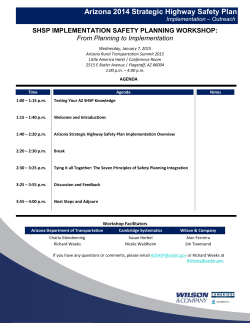
08-15 Paper 6 - senedd.assembly.wales
Public Accounts Committee PAC(4)-08-15 Paper 6 Welsh Assembly Public Accounts Committee Professor R J Lark BSc(Eng), ACGI, PhD, CEng, FICE Dean of Education and Students College of Physical Sciences and Engineering Deputy Director Cardiff School of Engineering Cardiff University, Queen‟s Buildings The Parade Cardiff, CF24 3AA Robert (Bob) Lark is a Professor of Civil Engineering at the Cardiff School of Engineering, Cardiff University and has been involved in research, design and construction allied to the UK‟s transport infrastructure over a period of nearly 40 years. Of particular relevance to this inquiry is the time he spent with the then Gwent County Council, where he was involved with the assessment, repair and maintenance of the County‟s highway structures; his involvement with ICE Wales, Cymru, of which he was Chair in 2008/09 and to whose “State of the Nation” reports he has contributed; and his research interest in the application of BIM (Building Information Modelling) to the design, construction, maintenance and management of our highway infrastructure, which he is currently undertaking in collaboration with the Welsh Assembly Government, the UK Transport Catapult and both private and public service providers who work with the Welsh Government to deliver the design, construction and maintenance of Wales‟ highway network. This written evidence is given in the context of the above experience and represents a personal opinion. In-depth research has not been carried out into any of the issues identified, either in Wales or the rest of the UK, but it does address all three of the bullet points in the Terms of Reference, albeit only superficially in the case of the first of these. Does the Welsh Government’s approach to delivery of major trunk road projects provide value for money? The procedures that are currently being adopted by the Welsh Government are consistent with what is generally considered to be good practice in the industry. Early Contractor Involvement (ECI) is considered to be key to efficient planning, the provision of reliable cost and completion date estimates and the timely delivery of project outputs. The Welsh Government has been closely involved with the development of ECI and, while there are still undoubtedly procedural and contractual issues that would benefit from refinement, it doesn‟t seem unreasonable to assume that this still represents an attractive and viable way of ensuring value for money in the delivery of trunk road projects. What may be further investigated is whether even closer alliances / public private partnerships / private finance initiatives might be established with such providers to benefit from their commercial management and ability to invest in research and development, although this may detract from the benefits of competitive tendering that can be obtained at different points in the current procurement protocols. Public Accounts Committee PAC(4)-08-15 Paper 6 Highway maintenance and improvement. Highway maintenance requires consideration of many diverse assets including the highway pavement, bridge structures, culverts, tunnels, retaining walls, earthworks, drainage, lighting and street furniture such as signage, all of which are currently dealt with in many different ways. In some cases, such as for the highway pavement, condition monitoring techniques are relatively sophisticated and the management of maintenance and repair regimes can follow well established protocols. However, in the case of highway structures and secondary features such as drainage, maintenance is often much more reactive, albeit often being triggered as a result of a routine inspection. Asset management procedures are less welldeveloped and, as a consequence, the timing and cost certainty of the work that is required is much less well defined leading to inefficiencies and reduced value for money. Equally challenging is that currently there is very little linkage between the management systems that are used for the different asset categories and therefore when it comes to cross asset prioritisation comparable measures of value, reliability and risk are not readily available. Bridge and Structure management systems have been developed and, in some cases, very successfully deployed, but their output cannot readily be compared to or combined with that of the widely available pavement management systems or the more adhoc and often locally developed databases used for managing drainage systems, lighting networks, road markings and signage etc. Research is required to identify common characteristics, measures of condition, reliability and risk and techniques whereby these measures can be compared across assets so that informed and defensible decisions can be made as to how to ensure best value is achieved in highway maintenance and improvement. The Highways Maintenance Efficiency Programme, HMEP, funded by the Department of Transport, seeks to deliver improved highways management in an environment of tighter budgets, rising costs and greater demand from consumers by providing tools and resources to address the above challenges. It is appropriately based on asset management principles and provides a framework for a whole-life approach to the management of highway assets, which has the potential to yield significant savings if it can be applied across the board. For this to happen collaboration is essential and while HMEP provides „toolkits‟ to facilitate this, what is still lacking is a universally applicable methodology that can truly support and drive forward this approach. To achieve this, a step change in highway infrastructure asset management is required in the form of a high powered (Cloud Computing based), intelligent and BIM compliant decision making framework for the "real time operation, maintenance and improvement of a highway network". This should provide a flexible system that would enable the Welsh Government and their Maintaining Agents to meet their statutory duties for safety, while minimising the whole life costs of the assets for which they are responsible and achieving their wider policy objectives. It would be founded on BIM based standards/processes that could combine traditional inventory and condition data with the output of condition monitoring and evaluation surveys to provide a basis for the real time performance management, decision making and intervention required to optimise scheme development and prioritise budget limited asset group investment strategies. The innovation required to facilitate this would lie in the development of BIM (level 2) standards for highways to facilitate real time and risk based multi-criteria decision making through the processing of large scale "big data" supplied by multiple, life cycle stakeholders. The big picture would be to enhance the decision making processes associated with the management of highway networks to ensure that service levels are sufficient to meet the needs of Wales‟ economy, health and education agendas. Such a development could Public Accounts Committee PAC(4)-08-15 Paper 6 provide vital tools to enhance the optimisation and decision making processes that are fundamental to maintaining the serviceability and safety of a highway network within the constraints of a limited budget. As such it could underpin a smarter and more cost effective approach to asset management and offer the step change needed for a more sustainable approach. Such a development could also demonstrate how science and lateral thinking might contribute to improving highway management practice and facilitating behavioural change. To conclude, to achieve a more efficient approach to the management of Wales' highway network and to obtain better value for the money invested for this purpose there is a need for greater collaboration between the Welsh Government, their agents and the contractors responsible for the delivery of both new works and the maintenance of existing infrastructure. To achieve this there is a need for research and development into the deployment of BIM compliant highway management systems that can build on the recently developed Integrated Road Information System (IRIS) and, given the special characteristics of the Welsh highway network, a Welsh based public / private partnership might be an appropriate way of delivering this. R. J. Lark 04/03/15
© Copyright 2025













